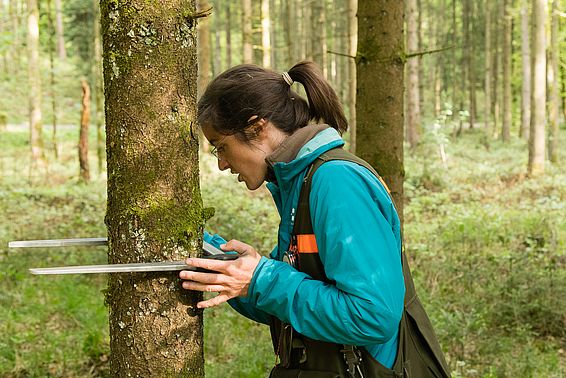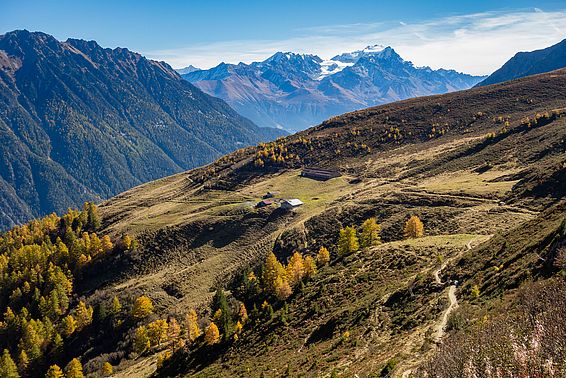10.09.2021 | Beate Kittl | News WSL
Given that the forest area is not expanding at the same rate everywhere, the central point of Switzerland's forests is moving in an east-south-easterly direction. In the eight years between the third and fourth National Forest Inventories (NFIs), the displacement was 460 metres. On 10 September, those involved in the NFI buried a certificate in a ceremony at the new location on the Älggi Alp in Sachseln (canton of Obwalden), not far from the geographical centre of Switzerland.
Birmensdorf, 10.9.2021 - Switzerland's forest area is expanding as agriculture is abandoned in some mountainous locations. The clearest evidence of this is that the mathematical midpoint of Swiss forests is creeping south-eastwards. That is one of the findings of the National Forest Inventory (NFI), carried out in nine-year cycles by the Swiss Federal Institute for Forest, Snow and Landscape Research (WSL) and the Federal Office for the Environment (FOEN). The NFI has been recording the condition of and changes to Swiss forests for almost 40 years.
The forest midpoint has moved because new forest has not sprung up in all parts of the country. Since the first NFI in 1983–85, the central point has shifted a total of 3.2 kilometres to the east-south-east. According to analysis of the fourth NFI (2009–17), it now lies on the Älggi Alp in Sachseln. Those involved in the NFI buried a certificate at the spot on 10 September 2021.
In what Christoph Fischer, Deputy Head of the NFI Programme, describes as "a happy coincidence", the new forest midpoint is now close to the geographical centre of Switzerland in the canton of Obwalden. He goes on: "As we are continually monitoring Switzerland's forest area through the NFI, we can track how it changes and so pinpoint the reasons for the shift in the forest midpoint."
More forest in the Alps ¶
Across Switzerland as a whole, the forest area has expanded by around 300 square kilometres since the third NFI (2004–06). That is an area roughly the size of the canton of Schaffhausen. On the Swiss Central Plateau and in the Jura, there was no change in the forest area over this period, with the Forest Act preventing any reduction. In the Pre-Alps and Southern Alps, the area grew slightly, but the biggest increase – 5% – occurred in the Alps, which accounted for 70% of the new forest (210 out of 300 square kilometres).
Calculated for Switzerland as whole, the forest midpoint has therefore moved to the south. In addition, the forest area in eastern parts of Switzerland expanded more than in the west, which is why the midpoint has also shifted eastwards.
Most of the increase in forest area occurred at over 1,400 metres above sea level, with almost half at over 1,800 metres. New forest is therefore mainly being created on alps and lower mountain pastures (Maiensässe). However, the forest midpoint moved much more slowly between the third and fourth NFIs than in the preceding periods – only 60 metres a year compared with 130 metres. This is because, in Ticino at least, there are now very few open spaces in which new forest could grow at all. Farmers there abandoned hard-to-access, unprofitable land decades ago.
The fact that the forest area on the Central Plateau has not changed since the first inventory, i.e. has not shrunk either, should be seen in a positive light, according to Christoph Fischer. "That's thanks to the strict protection of the forest area and, in my view, is a real boon for the population as it means everyone is within easy reach of forest for leisure and recreation."
The Swiss National Forest Inventory NFI
The Swiss National Forest Inventory (NFI) records the current state and the changes of the Swiss forest. The survey obtains data about trees, stands, sample plots as well as data from enquiries at the local forest service. We publish results about forest area, stem count, volume, increment, yield and many more.
The NFI is carried out by the Swiss Federal Institute for Forest, Snow and Landscape Research (WSL) in collaboration with the Federal Office for the Environment (FOEN ). The WSL is responsible for the planning, survey and analysis, as well as the scientific interpretation and publication of the NFI. The political interpretation and implementation is done by the Forest Division.
The inventory was carried out for the first time in 1983–1985 (NFI1), followed by three additional surveys in 1993–1995 (NFI2), 2004–2006 (NFI3), and 2009–2017 (NFI4). Since 2009, data have been collected continuously over a nine-year period. Currently, the fifth inventory is underway from 2018–26 (NFI5).
Contact ¶
Publication ¶
Links ¶
- LFI.ch
- The book (German or French) can be ordered free of charge (shipping costs will be due) at the WSL e-shop: https://shop.wsl.ch/
Copyright ¶
WSL and SLF provide the artwork for imaging of press articles relating to this media release for free. Transferring and saving the images in image databases and saving of images by third parties is not allowed.

